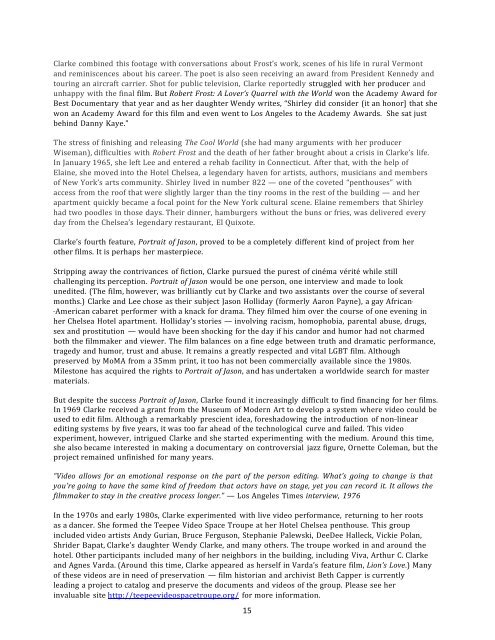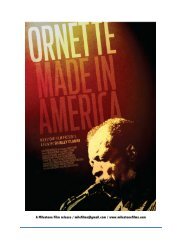Press Kit - Shirley Clarke
Press Kit - Shirley Clarke
Press Kit - Shirley Clarke
Create successful ePaper yourself
Turn your PDF publications into a flip-book with our unique Google optimized e-Paper software.
<strong>Clarke</strong> combined this footage with conversations about Frost’s work, scenes of his life in rural Vermont <br />
and reminiscences about his career. The poet is also seen receiving an award from President Kennedy and <br />
touring an aircraft carrier. Shot for public television, <strong>Clarke</strong> reportedly struggled with her producer and <br />
unhappy with the final film. But Robert Frost: A Lover’s Quarrel with the World won the Academy Award for <br />
Best Documentary that year and as her daughter Wendy writes, “<strong>Shirley</strong> did consider (it an honor] that she <br />
won an Academy Award for this film and even went to Los Angeles to the Academy Awards. She sat just <br />
behind Danny Kaye.” <br />
The stress of finishing and releasing The Cool World (she had many arguments with her producer <br />
Wiseman), difficulties with Robert Frost and the death of her father brought about a crisis in <strong>Clarke</strong>’s life. <br />
In January 1965, she left Lee and entered a rehab facility in Connecticut. After that, with the help of <br />
Elaine, she moved into the Hotel Chelsea, a legendary haven for artists, authors, musicians and members <br />
of New York’s arts community. <strong>Shirley</strong> lived in number 822 — one of the coveted “penthouses” with <br />
access from the roof that were slightly larger than the tiny rooms in the rest of the building — and her <br />
apartment quickly became a focal point for the New York cultural scene. Elaine remembers that <strong>Shirley</strong> <br />
had two poodles in those days. Their dinner, hamburgers without the buns or fries, was delivered every <br />
day from the Chelsea’s legendary restaurant, El Quixote. <br />
<strong>Clarke</strong>’s fourth feature, Portrait of Jason, proved to be a completely different kind of project from her <br />
other films. It is perhaps her masterpiece. <br />
Stripping away the contrivances of fiction, <strong>Clarke</strong> pursued the purest of cinéma vérité while still <br />
challenging its perception. Portrait of Jason would be one person, one interview and made to look <br />
unedited. (The film, however, was brilliantly cut by <strong>Clarke</strong> and two assistants over the course of several <br />
months.) <strong>Clarke</strong> and Lee chose as their subject Jason Holliday (formerly Aaron Payne), a gay African-‐<br />
-‐-‐American cabaret performer with a knack for drama. They filmed him over the course of one evening in <br />
her Chelsea Hotel apartment. Holliday’s stories — involving racism, homophobia, parental abuse, drugs, <br />
sex and prostitution — would have been shocking for the day if his candor and humor had not charmed <br />
both the filmmaker and viewer. The film balances on a fine edge between truth and dramatic performance, <br />
tragedy and humor, trust and abuse. It remains a greatly respected and vital LGBT film. Although <br />
preserved by MoMA from a 35mm print, it too has not been commercially available since the 1980s. <br />
Milestone has acquired the rights to Portrait of Jason, and has undertaken a worldwide search for master <br />
materials. <br />
But despite the success Portrait of Jason, <strong>Clarke</strong> found it increasingly difficult to find financing for her films. <br />
In 1969 <strong>Clarke</strong> received a grant from the Museum of Modern Art to develop a system where video could be <br />
used to edit film. Although a remarkably prescient idea, foreshadowing the introduction of non-‐-‐-‐linear <br />
editing systems by five years, it was too far ahead of the technological curve and failed. This video <br />
experiment, however, intrigued <strong>Clarke</strong> and she started experimenting with the medium. Around this time, <br />
she also became interested in making a documentary on controversial jazz figure, Ornette Coleman, but the <br />
project remained unfinished for many years. <br />
“Video allows for an emotional response on the part of the person editing. What’s going to change is that <br />
you’re going to have the same kind of freedom that actors have on stage, yet you can record it. It allows the <br />
filmmaker to stay in the creative process longer.” — Los Angeles Times interview, 1976 <br />
In the 1970s and early 1980s, <strong>Clarke</strong> experimented with live video performance, returning to her roots <br />
as a dancer. She formed the Teepee Video Space Troupe at her Hotel Chelsea penthouse. This group <br />
included video artists Andy Gurian, Bruce Ferguson, Stephanie Palewski, DeeDee Halleck, Vickie Polan, <br />
Shrider Bapat, <strong>Clarke</strong>’s daughter Wendy <strong>Clarke</strong>, and many others. The troupe worked in and around the <br />
hotel. Other participants included many of her neighbors in the building, including Viva, Arthur C. <strong>Clarke</strong> <br />
and Agnes Varda. (Around this time, <strong>Clarke</strong> appeared as herself in Varda’s feature film, Lion’s Love.) Many <br />
of these videos are in need of preservation — film historian and archivist Beth Capper is currently <br />
leading a project to catalog and preserve the documents and videos of the group. Please see her <br />
invaluable site http://teepeevideospacetroupe.org/ for more information. <br />
<br />
15




